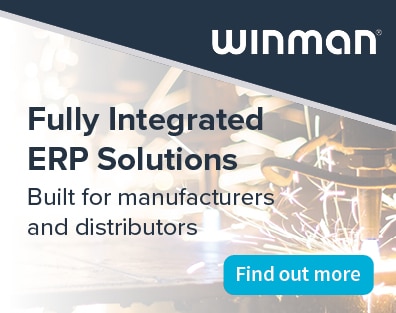 SAP has long been an ERP system of choice for manufacturing organisations, with many companies still using instances that have been in place for a decade and more. This stable work-horse of the industry has been a backbone of supply chains for years, but with the current ECC6 iteration being phased out in the not-too-distant future (support for the platform will cease in 2025), many businesses are already evaluating SAP’s next-generation business suite, SAP S/4HANA.
SAP has long been an ERP system of choice for manufacturing organisations, with many companies still using instances that have been in place for a decade and more. This stable work-horse of the industry has been a backbone of supply chains for years, but with the current ECC6 iteration being phased out in the not-too-distant future (support for the platform will cease in 2025), many businesses are already evaluating SAP’s next-generation business suite, SAP S/4HANA.
With six years left before that deadline, there may not seem to be an urgent rush to adopt S/4HANA, although it’s worth bearing in mind that SAP are predicting the biggest rush between 2021-2023, which will inevitably mean increased demand for implementation services at this time.
There is another arguably more pressing reason for companies to make the change sooner rather than later. The nature of business itself has changed drastically during the five, ten or even twenty years that many organisations have spent working with (more-or-less) the same ERP system. This is especially true for manufacturing companies – upgrades and custom developments have, to a point, enabled them to change with the times, but at its core, ECC remains a product built for how business used to be done.
For manufacturers, as well as other warehousing and distribution operations within wider supply chains, there are many benefits to be reaped by getting ahead of the competition in adopting a next-generation business suite such as SAP S/4HANA. But beyond the frequently covered benefits of HANA’s in-memory processing, what are some of the other major, though perhaps less obvious, benefits?
Since its initial release in early 2015, S/4HANA has (as you’d expect) received a number of updates to enhance functionality and usability. Whereas the earlier iterations were focused on finance and accounting, the latest release includes more wide-ranging modules to support activities in sales, procurement, controlling, planning and scheduling, plant maintenance and product lifecycle management, among other manufacturing and warehouse processes.
By leveraging the decades of experience SAP have accumulated working with the manufacturing industry and many sub-sectors within it, organisations are able to fully integrate business processes and operations with a single solution. With S/4HANA, this can be achieved in a more refined and profitable way than ever before.
Given the large number of users that an ERP system must support and the frequency with which users will interact with the system, user-friendliness has a direct impact on training times, productivity and the accuracy of information and workflows.
S/4HANA is built on the successful SAP Fiori UI to make it quick, easy and intuitive to use. Training is minimal and the common interfaces across modules enable users to easily and quickly learn new tasks. Information can be easily interpreted via a host of dashboard and reporting options, providing quick-to-read visual aids for management to help inform not just day-to-day, but moment-by-moment decision-making.
In a side-by-side comparison of using Fiori vs SAP GUI to complete common receivables processes, Fiori reduced the time taken to complete the tasks by a whopping 64%.
To support the increasing complexity of business processes that have grown or evolved outside of the scope of official SAP modules, most companies have invested heavily in custom developments that support their unique requirements. Over time, many of these have either grown to become slow and cumbersome systems, or in some cases have fallen out of use entirely.
SAP have spent many, many years working with a wide range of businesses across the manufacturing industry and during this time have collated and developed a detailed set of best practices for various sub-sectors. By incorporating these best practices into S/4HANA in a “pick-and-choose” fashion, companies do not have to invest so heavily in custom designs and instead, are able to utilise the experience of others to create the most efficient way of working that matches their own business and strategies. This simple yet flexible feature reduces the overall complexity of the system, in addition to reducing implementation times, simplifying system management and creating far more flexibility to easily adapt and meet business needs as they evolve.
Analytics have become the cornerstone of informed, up-to-date decision making for modern businesses, making the wealth of data held in ERP systems even more valuable than ever. To get the most out of it and enable companies to capitalise on the increasingly rapid changes in markets, that information needs to be visualised in real-time and in a concise, easily understandable fashion.
Instead of limited, bolt-on analytics solutions, S/4HANA introduces embedded analytics with extensive standardised reporting functionality for a variety of industry-specific scenarios. Based on the friendly SAP Fiori UI and utilising modern graphical representations of data to aid with swift visual interpretation, instantly accessible reports on the state of operations are available to users at all levels and tailored to their individual needs.
Even though the idea of initiating such a fundamental change with the business, unless absolutely necessary, may seem like too much to bear, it’s highly likely that the rewards will drastically outweigh the risks – IF the project is carried out properly. Make sure that you have the necessary skills and executive oversight to ensure the project’s success and further, that any implementation partner you choose has the required experience – not just with SAP systems, but with your individual business – to ensure that you get the right ERP for your individual needs.
https://www.invenio-solutions.com/blog/why-sap-s-4-hana-for-manufacturing






